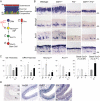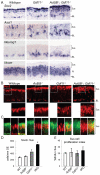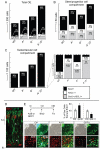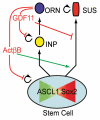Activin and GDF11 collaborate in feedback control of neuroepithelial stem cell proliferation and fate
- PMID: 21852401
- PMCID: PMC3171217
- DOI: 10.1242/dev.065870
Activin and GDF11 collaborate in feedback control of neuroepithelial stem cell proliferation and fate
Abstract
Studies of the olfactory epithelium model system have demonstrated that production of neurons is regulated by negative feedback. Previously, we showed that a locally produced signal, the TGFβ superfamily ligand GDF11, regulates the genesis of olfactory receptor neurons by inhibiting proliferation of the immediate neuronal precursors (INPs) that give rise to them. GDF11 is antagonized by follistatin (FST), which is also produced locally. Here, we show that Fst(-/-) mice exhibit dramatically decreased neurogenesis, a phenotype that can only be partially explained by increased GDF11 activity. Instead, a second FST-binding factor, activin βB (ACTβB), inhibits neurogenesis by a distinct mechanism: whereas GDF11 inhibits expansion of INPs, ACTβB inhibits expansion of stem and early progenitor cells. We present data supporting the concept that these latter cells, previously considered two distinct types, constitute a dynamic stem/progenitor population in which individual cells alternate expression of Sox2 and/or Ascl1. In addition, we demonstrate that interplay between ACTβB and GDF11 determines whether stem/progenitor cells adopt a glial versus neuronal fate. Altogether, the data indicate that the transition between stem cells and committed progenitors is neither sharp nor irreversible and that GDF11, ACTβB and FST are crucial components of a circuit that controls both total cell number and the ratio of neuronal versus glial cells in this system. Thus, our findings demonstrate a close connection between the signals involved in the control of tissue size and those that regulate the proportions of different cell types.
Figures








References
-
- Battiste J., Helms A. W., Kim E. J., Savage T. K., Lagace D. C., Mandyam C. D., Eisch A. J., Miyoshi G., Johnson J. E. (2007). Ascl1 defines sequentially generated lineage-restricted neuronal and oligodendrocyte precursor cells in the spinal cord. Development 134, 285-293 - PubMed
-
- Baumgardt M., Karlsson D., Terriente J., Diaz-Benjumea F. J., Thor S. (2009). Neuronal subtype specification within a lineage by opposing temporal feed-forward loops. Cell 139, 969-982 - PubMed
-
- Beites C. L., Kawauchi S., Crocker C. E., Calof A. L. (2005). Identification and molecular regulation of neural stem cells in the olfactory epithelium. Exp. Cell Res. 306, 309-316 - PubMed
Publication types
MeSH terms
Substances
Grants and funding
- T32 GM008620/GM/NIGMS NIH HHS/United States
- HD32067/HD/NICHD NIH HHS/United States
- R01 DC003583/DC/NIDCD NIH HHS/United States
- GM076516/GM/NIGMS NIH HHS/United States
- NS07444/NS/NINDS NIH HHS/United States
- NS032817/NS/NINDS NIH HHS/United States
- P50 GM076516/GM/NIGMS NIH HHS/United States
- P30 CA062203/CA/NCI NIH HHS/United States
- R01 HD032067/HD/NICHD NIH HHS/United States
- DC03583/DC/NIDCD NIH HHS/United States
- T32 NS007444/NS/NINDS NIH HHS/United States
- GM08620/GM/NIGMS NIH HHS/United States
- R01 NS032817/NS/NINDS NIH HHS/United States
LinkOut - more resources
Full Text Sources
Other Literature Sources
Molecular Biology Databases
Miscellaneous

